From Iwon to Chosin:
A Photo Essay
We present here a photo essay beginning before the landing of RCT 31 units at the beach of Iwon, about 100 miles northeast of Wonsan. This essay is designed to provide the viewer with an appreciation for the terrain and related conditions that existed in northeast Korea. During their peacetime assignment in Japan many soldiers took advantage of the inexpensive cameras in the Post Exchange. Many of these photographs were taken by Captain Joseph C. Rodgers, a medical service officer of Medical Company, 31st Infantry, whose medical detachment was assigned to the 2d Battalion, 31st Infantry, a unit which made it into the Koto‐ri on 1 December and remained in defense of that perimeter until the breakout. Unless otherwise noted, the original photos are color slides.
Click on any photo to see a larger one
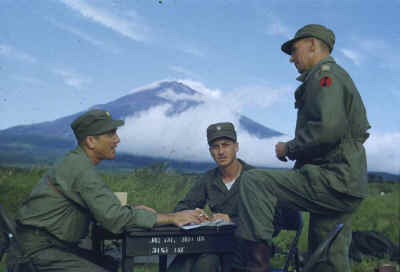
This photograph was taken a few weeks before the regiment loaded out
of Yokohama for Korea. Right: Major Lester K. Olson, regimental S‐3 (operations
officer) who was seriously wounded during the action south of the Suwon airfield and
evacuated. Center: Lieutenant Colonel William Reilly, commander of the 3d Battalion, 31st
Infantry, seriously wounded the night of 27‐28 November at the Inlet east of the
Chosin Reservoir and one of the few to be evacuated from that action. Left: Major Berry K.
Anderson who at the time of the photo was S‐3 of the 3d Battalion, 31st Infantry.
After Major Olson was wounded he was transferred to the position of regimental S‐3,
promoted to lieutenant colonel in early November 1950, and at the Chosin Reservoir was
senior Army officer present in command of the "Provisional Battalion" attached to
the 7th Marines for the breakout. All officers in the photo are deceased.
Photo
by (then 1st Lt) George Rasula.
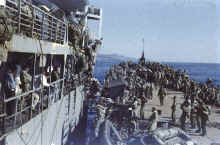
TROOPS LAND AT IWON, NORTH KOREA
Photo GR‐04 (1)
The troopship
MARINE LYNX discharges soldiers of the 2d Battalion, 31st Infantry, to an LST which will
carry then to the beach at Iwon, North Korea. Photo courtesy George Rasula.
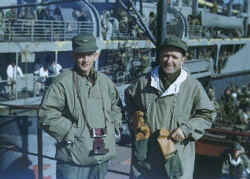
Photo GR‐08 (2)
Captain George Rasula and 1st Lieutenant Frank Bunn of Headquarters, 31st Infantry, aboard LST at Iwon harbor. Note the reversible parka shell being worn, inside being white. Under this was worn the standard field jacket with pile liner, wool shirt and winter underwear, similar to that worn by the 10th Mountain Division in WW II. Note also the trigger‐finger mitten shells, in which was worn the wool mitten also with trigger finger. Soldiers who were with the regiment the previous winter in Hokkaido received training in winter survival as well as use of skis and snowshoes. Photo courtesy George Rasula.
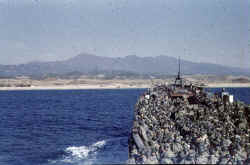
Photo GR‐02 (3)
LST heading for beach at Iwon. Note the rugged mountains in the distance, terrain into which this battalion was about to enter. Photo courtesy George Rasula.
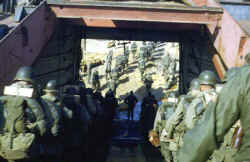
JR2‐48 (4)
Troops debark from LST using main ramp to beach at Iwon. All landings in northeast Korea were unopposed. Photo courtesy Joseph Rodgers.
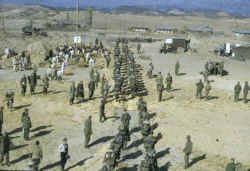
JR2‐47 (5)
Units of 2d Battalion, 31st Infantry, begin march inland from the beach at Iwon. Eventually trucks will carry them north to Pukchong, then west into the area northeast of the Fusen (Pujon) Reservoir. Photo courtesy Joseph Rodgers.
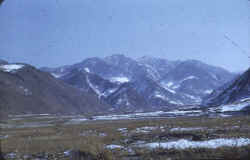
JR2‐63 (6)
Rugged terrain seen by troops as they motored north to the Pukchong area. Photo courtesy Joseph Rodgers.
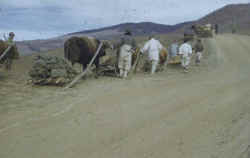
JR2‐65 (7)
Oxen pulling supply sleds into mountains near the Fusen Reservoir. Photo courtesy Joseph Rodgers.
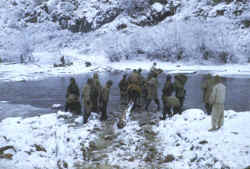
JR2‐71 (8)
Early snows following by melting caused streams to swell, creating crossing problems for units as they moved into roadless terrain. Photo Courtesy Joseph Rodgers.
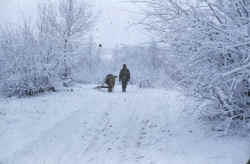
JR2‐67 (9)
Lone soldier walking ox with sled used to carry supplies into snow‐covered terrain being traversed by units of 2d Battalion, 31st Infantry, near Fusen Reservoir. Photo courtesy Joseph Rodgers.
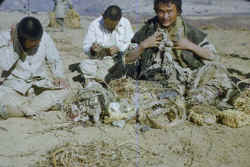
JR2‐56 (10 )
Captured North Korean soldiers. Note the camouflage dress on soldier at the right who probably had been a sniper. Photo courtesy Joseph Rodgers.
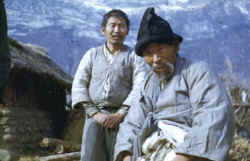
JR2‐74 (11)
North Korean father and son. Photo courtesy Joseph Rodgers.
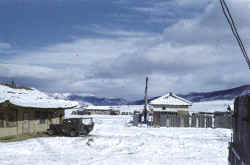
GR‐05 (12)
Village of Untaek, North Korea, east of the Fusen (Pujon) Reservoir on 14 November 1950 when temperature was 14 degrees below zero F. RCT 31 headquarters was in a schoolhouse at this location prior to its move to the Chosin Reservoir. Photo courtesy George Rasula.
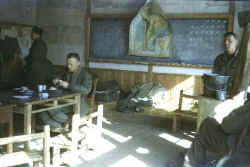
GR‐06 (13)
The officer’s mess in the Untaek schoolhouse command post of RCT 31. Of interest is the map of South America. Seated having a C ration lunch is Captain Frank Fife, the headquarters commandant, who eventually ended up at Koto‐ri. In the rear studying a map is Major Hugh Robbins, the RCT adjutant and a Chosin survivor, who went with Colonel MacLean to the RCT assigned sector at the Chosin Reservoir. Photo courtesy George Rasula.
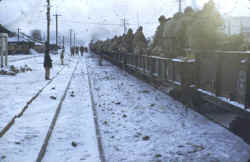
JR2‐78 (14)
After the units of RCT 31 were ordered to the Chosin Reservoir, the 2d Battalion, 31st Infantry (2/31), was the last unit moved from the Fusen Reservoir area. Here they are shown boarding narrow‐gauge railroad cars for part of the move south toward Hamhung. Photo courtesy Joseph Rodgers.
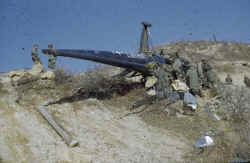
JR2‐80 (15)
Marine helicopter crash in the Funchilin Pass. Photo courtesy Joseph Rodgers.
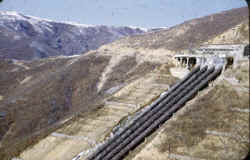
JR2/82 (16)
The gatehouse in the Funchilin Pass with partially blown bridge, as this photo was taken during the move north by 2/31 Infantry on 30 November 1950. The bridge was eventually replaced by a Treadway bridge on 9 December during the breakout from Koto‐ri. Photo courtesy Joseph Rodgers.
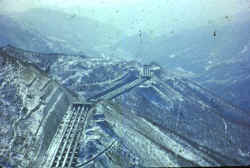
JR2‐81 (17)
Four large pipes carry water from the Chosin Reservoir downhill from the gatehouse to the power plant in the valley below.
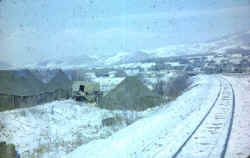
JR2‐84 (18)
Winter tent camp inside the perimeter at Koto‐ri which was manned by units from the 2d Battalion, 1st Marines (including Colonel Puller’s 1st Marine Regiment command post); 185th Engineer Battalion, X Corps; 2d Battalion, 31st Infantry. 7th Infantry Division; and other company‐size and smaller units.